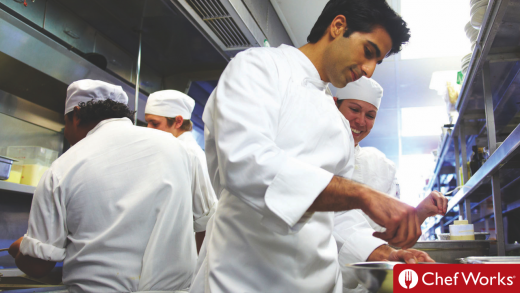
Whether you dream of becoming a chef or already hold Michelin stars, dressing the part is essential. The attire you wear should convey professionalism, capability, and practicality. In this article, we delve into the historical significance of chef uniforms and interview Chef Matt Watts from Boqueria UES, a storied Spanish tapas restaurant in New York City.
Chefs and their uniforms
Chefs have a wide range of attire, from the traditional white chef jackets and tall hats worn by French haute cuisine chefs to the utilitarian working uniforms of modern-day line cooks.
The iconic tall white hat, known as the toque blanche, was popularized by Marie-Antoine Carême, a pioneer of French haute cuisine in the 18th century. Hailed the “king of chefs and the chef of kings,” as well as “the world’s first celebrity chef,” Carême’s influence continues to this day, with chefs wearing white to symbolize cleanliness and professionalism. The traditional French uniform, as established by Carême, featured a white double-breasted jacket, black and white checked trousers, and the tall white hat.
Legend has it, traditional button chef coats are double-breasted because if you get anything on the front, it can be reversed so chefs can walk right back into the dining room to talk to guests.
The toque blanche itself was meant to keep hair out of the way, but that’s not the only part of the chef uniform that’s purpose-oriented. Modern chef coats, such as those from Chef Works’ Cool Vent selection, have ventilated sides for operating in high-heat conditions.
Interview with the chef: Matt Watts
To gain an insider’s understanding on a chef’s attire, we interviewed Chef Matt Watts from Boqueria Upper East Side to get his take on the topic. Born and raised in Costa Rica, Matt has a decade of experience in the industry, working in some of the top restaurants in New York City. Along the way, he’s collected several things, from worldly experiences to interesting stories, as well as several pieces of favorite chef gear.
In response to what’s important to a chef, Matt doesn’t mince words: “For me, it’s always been function over fashion. Style is secondary to function. Looking professional, however, is not to be overlooked.”
Chef hats
Matt has witnessed a variety of chef hats throughout his career, from tall white hats to skullcaps. The smaller pillbox hats, known as commis hats, are often worn by beginners or commis chefs. However, Matt prefers a more nontraditional approach, opting for a baseball cap or classic skullcap. At Boqueria, many of the chefs wear one-size-fits-all baseball caps embroidered with the company name.
Coat
The chef’s coat might not make the chef but it’s certainly a big part of the look. Matt has collected multiple coats over the years, as past kitchens let chefs keep their uniforms even after they leave. At Boqueria, the standard issue is the Chef Works’ Springfield Chef Coat.
“It’s traditional to have the long sleeves with really long cuffs that you fold back, but I’m partial to the short-sleeve cuffs because of the heat. You don’t stain the sleeves as much, and it’s easier to maintain,” says Matt. He owns the stylish Rochester Chef Coat, noting his appreciation for both the ventilated sides (“Quite nice!”) as well as its easy-use zipper wear.
Apron
Aprons are essential for chefs, although when and where they’re used may vary depending on the station a chef occupies.
“I have two of my own aprons,” Matt points out, listing two solid apron brands: “a Tilit as well as a Bragard.” The best aprons need to strike a balance between durability, ease of maintenance, and lightweight material to ensure they don’t hinder a chef’s duties.
The choice apron for the staff at Boqueria? The Berkeley Bib Apron. Made of strong denim, it’s tough, light, and features some really nice-to-haves: strong over-the-shoulder suspender ties and loads of pocket space.
Pants
While black and white checkered pants are considered traditional for chefs, Matt prefers simplicity and comfort. Loose-fitting, comfortable, and preferably dark (hard to stain) pants are his preferred choice.
Shoes
Chefs have a plethora of options when it comes to footwear. Although Crocs may seem like a fashion faux pas, many chefs appreciate their ergonomic design, non-slip soles, and lace-free construction, which eliminates the risk of tripping in a bustling kitchen.
Matt takes into mind those factors when he’s choosing footwear, but most days, you’ll find him sporting combat boots: “I usually wear Docs — they’re non-slip, and pretty tough when it comes to stuff falling on them.”
He lets slip an anecdote about running into an incident where an entire broken refrigerator door once dropped on his Doc Martens-clad foot and him being none the worse for it. What about potentially tripping over the laces? “Double knotted laces,” is Matt’s matter-of-fact response.
Next-level upgrades
We inquired about the first aspect Matt would prioritize if given the opportunity to upgrade his gear game and how he would go about it.
“I’d probably look for something with lots of pockets. Shoulder pockets, breast pockets. They come in super handy.” Many of the aprons come with plenty of places to put things, and it makes sense for a chef in motion to be outfitted with plenty of storage space.
Bottom line
Whether you’re looking to go into the industry or simply stocking up your home kitchen, it always makes sense to go to the source; say, a chef at a top New York City restaurant.
We are proud to supply Boqueria: their restaurants feature beautiful decor at multiple locations in NYC and a wide menu of classic Barcelona Spanish tapas dishes. If you get the chance to visit, you might find the opportunity to witness Matt managing the bustling team there.
We take pleasure in presenting fresh perspectives on all things chef-related, and getting acquainted with the dedicated chefs and kitchens that depend on Chef Works gear every day.


